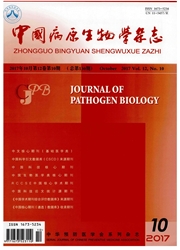

 中文摘要:
中文摘要:
目的分析华支睾吸虫感染新西兰兔转化生长因子β1(TGF—β1)、白细胞介素17(IL-17)的变化及意义。方法选择健康新西兰兔8只,经口灌胃华支睾吸虫囊蚴800个;于感染0、1、3、7、14、21、28和42d耳缘静脉采血,分离血清,用ELISA法检测血清中TGF81、IL-17水平;于42d剖杀感染兔,取肝脏制作组织切片,HE染色观察病理变化。结果实验兔感染0d时TGF-β1为(706.08±60.72)pg/ml,感染42d时为(1106.26±60.35)pg/ml,差异有统计学意义(P〈0.01)。IL-17水平自感染开始持续增高,在感染3d时[(68.69±6.04)pg/m1]达到最高峰,与感染0d[(50.04±4.16)pg/m1]时相比,差异有统计学意义(P〈0.05);此后逐渐降低,至21d时降至感染前水平。结论新西兰兔感染华支睾吸虫早期IL-17高表达,感染42d时TGF-β1高表达。提示TGF-β1/IL-17在华支睾吸虫致病过程中发挥重要作用。
 英文摘要:
英文摘要:
Objective To explore dynamic changes and the significance of transforming growth factor-β (TGF-β1) and interleukin-17 (IL-17) in rabbits infected with Clonorchis sinensis. Methods Eight healthy New Zealand rabbits were infected with 800 C. sinensis metacercariae, and blood was collected via the auricular vein. Serum was separated on day 0 (the control) and on day 1, 3, 7, 14, 21, 28, and 42 post-infection (p. i. ). Levels of transforming growth factor-131 (TGF-β1) and interleukin-17 (IL-17) in serum were determined using an enzyme-linked immunosorbent assay (ELISA). The rabbits were sacrificed 42 days p. i. , and pathological changes in liver tissues were a/nalyzed using HE staining. Re- suits Compared to the control, the level of TGF-131 expression peaked on day 42 p.i. (1106.26±60.35 pg/ml vs 706.08 ±60.72 pg/ml, P〈0.01). The level of IL-17 expression increased continuously during initial infection, it peaked on day 3 p.i. (68.69±6.04 pg/ml versus 50.04±4.16 pg/ml for the control, P〈0.05), and then it deceased slowly to the le el of infection noted on day 21. Compared to liver tissue from normal animals, liver tissue from infected rabbits was destroyed according to HE staining, liver cells were deformed, and necrosis and partial fibrosis were observed 42 days p. i. Conclusion In a rabbit animal model of clonorchiasis, a high level of IL-17 expression predominated during early infection but a high level of TGF-β1 predominated during later infection, suggesting that TGF-β1/IL-17 might play a part role in pathogenesis of C. sinensis.
 同期刊论文项目
同期刊论文项目
 同项目期刊论文
同项目期刊论文
 The expression dynamics of transforming growth factor-beta/Smad signaling in the liver fibrosis expe
The expression dynamics of transforming growth factor-beta/Smad signaling in the liver fibrosis expe Clonorchis sinensis excretory/secretory products promote the secretion of TNF-alpha in the mouse int
Clonorchis sinensis excretory/secretory products promote the secretion of TNF-alpha in the mouse int 期刊信息
期刊信息
